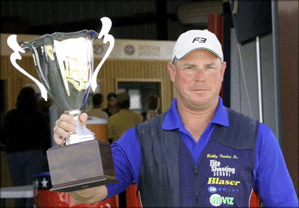Shotguns Up: Sporting Clays According to Bobby Fowler, Jr.
Common wisdom says one thing, Bobby Fowler Jr.’s trophy case says another.
Since he first started shooting competitively in 1993, Fowler has won about 150 titles in sporting clays and FITASC. He’s dominated the sports so thoroughly, that his middle initials should be HOA. Every gauge, on both sides of the Atlantic, in his home state of Texas – no tournament is safe from Fowler’s monumental skills in achieving the highest overall average.
You would think that Fowler’s success is based on the ultimate refinement of tried and true principles coupled with a persistent drive to win, relentless practice and razor-sharp mental skills. For the most part you would be right.
But Fowler’s approach to successful shooting hinges on one particular unorthodox method. When it comes to sporting clays, he pre-mounts his shotgun.

Pre-mounting a shotgun is associated with skeet and trap shooting. You step into the station, mount the gun, then call for the target. By contrast, sporting clays traces its roots to wingshooting, which itself calls for a low-gun mount. It’s only common sense that if you’re traipsing through the woods in search of birds, you can’t exactly have the gun already mounted to your shoulder. You hold the gun in a ready, low-gun position and when you see the bird take wing you mount and shoot in a single, smooth move.
While Fowler’s sporting clays mount isn’t 100 percent pre-mount, it sure comes pretty darn close. For example, the recoil pad is definitely against his shoulder as he prepares for the target. Unlike skeet or trap shooters, though, Fowler drops the stock only slightly from his face – just enough to add an extra margin of peripheral vision.
When asked why he uses pre-mount for sporting clays, he replied “One of the main reasons I shoot pre-mounted is that I find I’m on the target a lot faster.”
As he explained it, Fowler’s mount routine involves holding his head so that he can look back to where the bird is going appear – or in his case he generally looks back to “just off of the arm of the trap machine.” He’s now holding the muzzles about 30 degrees under the target flight path, although the recoil pad is firmly “in the pocket at all times.” He calls for the bird, establishes the target, raises the muzzle from under the line of the bird as he swings, and when the gun touches his face he pulls the trigger.
“The gun comes up and your head comes down just before you’re ready to pull the trigger,” he said.
In talking with him, we mentioned that we had tried shooting sporting clays pre-mounted and never found much success with it. Our problem was that, for whatever reason, the gun tended to jam up our swing on crossing shots. Fowler honed right in on the culprit.
“You don’t want to ride the bird out,” he observed. “You pre-mount the gun in the first place so you can shoot the bird faster.”
And in recalling our experience in shooting sporting clays pre-mounted, that exactly was what we did wrong. The correct movement is: gun to face, pull the trigger. You’ll find that the built-in gun speed allows you to sustain the proper lead – eliminating the back-and-forth mental calculations of trying to find the right forward allowance for each and every shot that causes you to ride the target too long.
When done correctly, Fowler’s approach can obviously work wonders.
“What happens is that shooters try it and the response is always that they can get on the bird quicker, and it’s fewer things to do than low mount when the bird comes out of the trap,” he told us. “It’s just easier to do it this way. It’s more natural for shooting clay targets.”
With fewer “moving parts” than a low-gun mount, Fowler’s style goes a long way toward improving consistency. And during our conversation, he underscored the importance of controlling recoil so that you can parlay that hard-earned consistency into a long-term shooting career.
“Recoil is something that starts to be a determining factor when you get older,” he explained. “You want the speed of the faster shells when you get older, but you don’t’ want to get beat up.”
Fowler said he uses Kick-EEZ recoil pads because they have Sorbothane.
If you’ve never heard of Sorbothane, it’s a unique polymer that has been medically and scientifically proven to be the best cushioning material available today. In many applications and laboratory tests shock-absorption levels of 90% have been achieved. These high absorption levels are possible because Sorbothane attenuates shock waves by dispersing energy outward from the impact source.
For Fowler’s pre-mounted sporting clays technique, the lowest possible recoil becomes extremely important.
“You want to get that shotgun up in the pocket real good,” he said.
Irwin Greenstein is Publisher of Shotgun Life. You can reach him at letters@shotgunlife.com.
Useful resources:
Kick-EEZ
http://www.kickeezproducts.com
Bobby Fowler Jr.’s Elite Shooting School

Irwin Greenstein is Publisher of Shotgun Life. Please send your comments to letters@shotgunlife.com.


Comments